 Jesse Neider has followed the lives of a young couple, both of whom are blind, as they got married and had three children over several years. Such stories are hard to predict. Sticking with them for the long haul is what produces the overarching narrative but telling individual stories within the whole is critical. Jesse Neider photo
Jesse Neider has followed the lives of a young couple, both of whom are blind, as they got married and had three children over several years. Such stories are hard to predict. Sticking with them for the long haul is what produces the overarching narrative but telling individual stories within the whole is critical. Jesse Neider photo
My favorite thing to help photographers with is producing a body of work that deserves to be a book. Call it a project, a major piece, a long form visual narrative, a documentary; present it as a book, an online presentation, a gallery show, a limited edition print series, doesn’t matter.
In the end, if what you produce has the breadth and depth, you can present it any way you want. And if you do it right, that body of work will have many legs. It could be the best thing you’ve ever done as a photographer.
There isn’t a single path to producing such a set of pictures, there’s no one way to make sure what you do will succeed. But there are some general principles and practices that you can follow to ensure a greater likelihood of success - that being a relative term. If you’ve never done an extended project, then just completing one would be huge. Publishing a book from your effort would be another, higher measure.
But let’s say that you’re sitting there wanting to start something new.
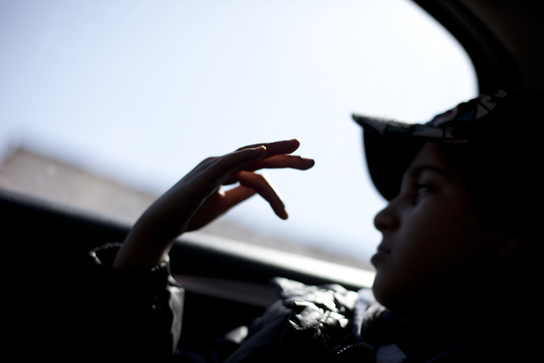 Jesse is doing another story about people with autism in Morocco. The challenge with multiple-subject stories is to carefully select people who, when combined, tell a more dynamic story than if you focused on one person. Jesse Neider photo
Jesse is doing another story about people with autism in Morocco. The challenge with multiple-subject stories is to carefully select people who, when combined, tell a more dynamic story than if you focused on one person. Jesse Neider photo
Why do longer term stories?
They are a pain to work on. They interrupt personal life. They interrupt work life - unless you’re lucky enough to have a job that supports project work. Why bother?
Working on lengthy efforts as a photographer, compared to producing single images, is the difference between writing a paragraph and writing a book. To conjure a subject worthy of such effort, to figure out a structure for the coverage, to get know subjects intimately with a camera, to edit the work into something greater than its parts is alone the worth the effort. But only if you care about growing as a photographer and therefore as a person.
I’ve always encouraged photographers to have multiple scales of stories going at all times, ones that you could do in a day, one that would take a week, a month, a year and one that never ends. The more interconnected any of these efforts are, the greater the potential for them all. That’s one approach to building a large body of work.
Some photographers only write photo sentences, some create poetic imagery, others link images into short stories and a few envision and execute novels of photographs. Each brings a gift to the creator. So why not expand your voice?
How do you start?
How do you come up with an idea that merits the effort? A lot of people stumble across subjects that seem to have enough range to justify the effort. That’s fine.
I’d suggest starting with a subject that you care about, whether you stumble upon it or have to push yourself to figure out what you care about. The more outside of your interest or what matters to you the subject is, the harder it will be to stick with the effort. And it is hard to bring such an effort to fruition.
Ask yourself if the subject you’ve chosen has enough going on from now forward to make pictures of active situations. A lot of people chose subjects because what has happened in the past is interesting but the story won’t develop much after you start making pictures. The most common example is a subject that has lived a rich life and the stories they can tell about that life are amazing. But in the present tense, they sit at home and watch television 10 hours a day. Not inherently interesting.
The disconnect is in the subject matter vs. what you can photograph, if you’re trying to tell a story that mostly happened in the past. You could certainly develop a set of pictures built around the idea of a fading life. KayLynn Deveney certainly did: “The Day to Day Life of Albert Hastings.”
A lot of people come up with these highfalutin ideas that are going to change the world or are so broad as to be undoable, if not meaningless: “Child poverty is bad and getting worse so I’m going to photograph it.’ Others follow their personal interests but don’t reach into the subject: “I like cross country skiing so I’m going to photograph it.”
Logistics can also be a barrier. Make sure you can pull off the story. If it takes three hours to get to everything you photograph, you’ll miss things. If you are self funding the effort, be realistic about what you can afford to support, both in terms of time and money.
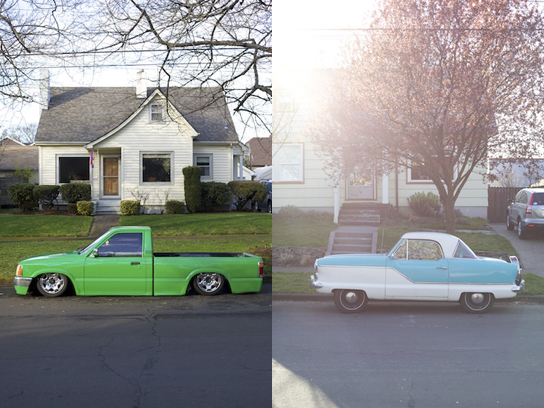 I always have what I call walkabout pictures in the works. This one is about what kinds of cars are parked in front of houses, always shot with a 50mm lens at f5.6 or so. Consistency in the making of the pictures holds them together as a group. This one won't change the world, but it's fun to do and it'll be more interesting 30 years from now when most of these cars will be gone and houses will be different. The essence then is to stop time for history's sake. Mike Davis photo
I always have what I call walkabout pictures in the works. This one is about what kinds of cars are parked in front of houses, always shot with a 50mm lens at f5.6 or so. Consistency in the making of the pictures holds them together as a group. This one won't change the world, but it's fun to do and it'll be more interesting 30 years from now when most of these cars will be gone and houses will be different. The essence then is to stop time for history's sake. Mike Davis photo
How do you create a structure for your effort; how do you understand what your subject is really about?
Once you have a topic or a subject, start doing research. Learn everything you can about that person, that place, that subject. See what else has been written, photographed, researched. If there are specialists in the subject, talk to them.
Or if you’re lucky enough to have stumbled on a subject that’s amazing, still learn everything you can.
If what you’re photographing has been photographed a lot, if it’s a cliché, then you better do all the more research to ensure that your version won’t be just another iteration on the heap. Strive to tell a unique story in spite of how trodden your topic is. (Unique diseases don’t make for unique stories, as one example.)
Start to write the snippets of what you know down the left side of a sheet of paper. Maybe it’ll take several sheets of paper. They can be facts, impressions, qualities, locations, personalities, numbers, whatever seems remotely relevant.
Then start to make connections from the snippets. Step back from the informational aspects and think in larger themes. What dots can you connect to make larger statements about your subject matter.
Take the child poverty example from above. Suppose you learn that more children live in poverty now than ever, that the state with the greatest change is x, that people earning a minimum wage are the largest group, that families with single parents account for a much high percentage and so on. Larger themes emerge, of change, of working poor, of children spending time alone, of exhaustion, of working against the odds.
The goal then is to find an approach to the subject that tells an interesting story, to the same degree and level of expectation that a movie story line is compelling.
Elements of successful story telling are a mixture of building tension and releasing it, of presenting an uplifting situation, and situations of frustration, humor, sadness, irony, tragedy, ecstasy. Pick a quality of life on the planet and it can be part of your story. The more the better. The fewer of these qualities, then the less engaging your movie of still pictures will be. A story line with only negative elements will probably fail just as one that’s completely happy. Yen without yang.
Keep looking into your subject until you find a situation that will have as many qualities as possible. I imagine telling a story of one class of children in a poverty-stricken area, where you do a story about children whose stories tell such a range. Or maybe there’s someone out there who is a champion to such people. Who knows what the story becomes but until you can say with some confidence that it will be dynamic, don’t start.
Sometimes you can use your camera to continue researching a subject. By entering a realm with your camera, you’ll begin to understand things more deeply, you’ll see things you can’t from afar and realize potentials.
Get to the point of certainty of locking in people and places to photograph and know why you’re photographing each, what qualities they encompass. Things will change and you should adapt the story line with changes but do so knowingly.
This much will give you a starting point. You should be able to say in a sentence what the story line and its major themes will be. If you can give it a title at this point, all the better. Your mission is set, make pictures that touch on the qualities of each setting, not just show what’s happening. Nothing is set in stone, but you have good direction to craft a body of work.
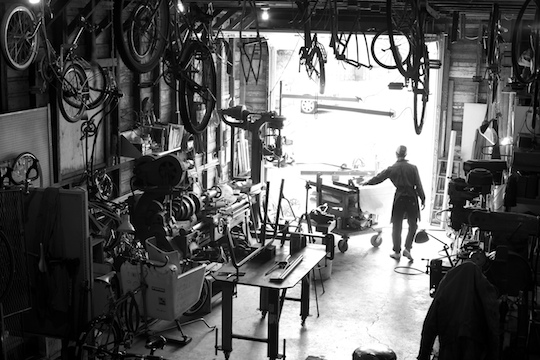 Another personal project is to photograph people who make bicycles by hand, in this case Metrofiets cargo bikes. I make a similar range of photographs in each builder's shop so that similarities and differences stand out. Mike Davis photo
Another personal project is to photograph people who make bicycles by hand, in this case Metrofiets cargo bikes. I make a similar range of photographs in each builder's shop so that similarities and differences stand out. Mike Davis photo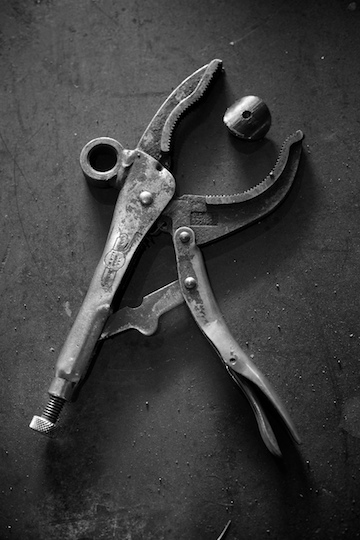 Details such as what kinds of tools they use and how they keep their shop says a lot about each bike builder.
Details such as what kinds of tools they use and how they keep their shop says a lot about each bike builder.
How do you know how it’s going?
It’s worth distinguishing between producing a coverage from which you’ll produce the story and trying to shoot the story as it progresses. I know, that sounds weird. Back to a movie analogy, think of how many scenes are photographed for a movie that don’t end up in the final cut.
Of course not everything you photograph will end up in the final edits. A variation of of producing a varied coverage in still photography involves producing a type of coverage that has many threads, many different ways of seeing scenes, different ways of making pictures.
To explain the opposite way of making pictures, a lot of people simply photograph as many things as they can as their subjects’ lives unfold. Each photograph has a similar goal - to show what’s happening - so every scene is photographed similarly. So regardless of what’s happening the photographs feel similar one scene to the next. Yet most settings have several different qualities to them, each of which can be photographed uniquely.
So think of the scenes more as threads of a tapestry and the goal is to convey the qualities of each setting, not just what’s happening. See the uniqueness of each setting and create a thread that folds into the whole tapestry more richly than it would if you saw each setting alike. One way to do this is to force yourself to make pictures from different distances in each setting - recognizing that distance is a powerful voice in your photography. Be aware of the relevance of the entire setting down to inches from aspects of the setting.
Use light, color, moment, composition and distance to the subject to their fullest to convey the qualities of each scene you’re in.
This alone will introduce a dynamic to your body of work. It will force you into deeper story telling that will allow a greater range of presentation.
It’s critical to edit your work as you produce it: Create a hierarchy of imagery (firsts, seconds and thirds are what I usually do) and begin to put pieces together, connect dots in the work you’ve done to show you what you did well, what you didn’t do, what needs to be done, to help you realize more about the story than you may have known.
Ideally, you’re working with a picture editor through this process, someone who can help you be aware of what’s working well, of what you’re not doing and to help focus the story as it progresses.
If you set out to convey the qualities of each scene and then choose photographs for the qualities they convey as you move through the story, you’ll build a set of pictures that are far more dynamic.
Having edited as you progress, it’s important to be confident in your choices, to not continually go back into the whole take and second guess things. Always moving forward, standing on the strength of what you’ve done will make a big difference. That said, it never hurts to peruse your outs now and then, in case there are things you missed. There is a difference between second guessing and double checking.
How do you know when you’re done?
Some efforts have logical ending points. Some don’t. When there isn’t a natural ending, how do you know how to close the story?
If you didn’t know from the beginning, one thing to ask yourself is if you want the project to end by asking or answering a question, by leaving things all neatly concluded or leaving loose ends for the viewer to wonder about? If the former, then you’ll have to wait for a natural ending. If the latter, then you can create your own ending.
Usually, if you’ve defined a subject but haven’t refined a story line or aren’t telling a specific, dimensional story, then you’re simply following the progression of things with your camera. In these cases, it’s particularly hard to figure out when to stop. You could go on forever. So one thing is to go back and ask yourself, what is the story, anyway?
And let me say this about what a story is: Following someone’s life endlessly can produce an engaging set of pictures. See Darcy Padilla’s Julie Project http://www.darcypadilla.com/thejulieproject/intro.html The scope and swing of her life produced a compelling body of work. The photographer’s insight, understanding, relationship and approach to making pictures had as much to do with the story’s success as did the subject matter.
You could follow a subject endlessly and never have a story. You may have thousands of pictures on a subject that don’t say anything people are interested in. How do you know if this is you? Ask people if they’d sit through a movie of your work? Be honest with yourself. What’s the title, your story description? Did you capture a sweep of the human dynamic or just make monosyllabic expressions of what your camera saw?
In these cases of roaming with a subject’s life you may well be done. But the story will come from the editing process more than from the way you’ve set out to tell the story.
On the other hand, if you were focused on what you set out to say, if you were sensitive to the nuances of subject as they changed and made dimensional photographs that reached the heart of situations, then you’ll probably know when you’re done. That’d be a wrap.
How do you edit the whole thing?
Now that you have a collection of photographs, how do you structure the final body of work?
The goal is to first get to a working set of pictures. By working set, I mean an reasonable number from which you’ll craft the final iteration. It’ll certainly help if you have edited as you’ve gone along.
At National Geographic magazine, this phase of the story is geared toward producing “The Tray,” from the days of slide trays that held up to 80 slides. Few stories went beyond one tray. We’d create the layout from that set of pictures.
It’s hard to know how big your tray will be. The scope of the story and the number of threads you’ve created determines the range of the images. Try not to do too tight an edit at each pass through your pictures. Each time, just ask, does this image meet a higher standard than the rest of the pictures. Then go through them again and raise the standard. If you have two equally good pictures of the same thing but they convey different qualities, then keep them both; if they say the same thing, chose one.
It usually helps to organize or group photos into the themes you’ve thought about and the editing process often discovers new connections, if you’re open to them. Sometimes those themes create chapters or groupings that are less distinctive than chapters but they still hold together as a subset.
Another approach is to create groupings. Then start sequencing the groupings. Groups can be anywhere from pairings to 10 or 20 images that work together.
The specific outcome can dictate some of this process. If it’s a book or a magazine spread or an online slide show or part of a multimedia presentation or a gallery show, the process can vary to accommodate the space.
Yet another approach, and one I’ve used more often than any other the past year or so, is to chose a first image and then do a split frame view in your software of choice (I use Photo Mechanic for this) and place that first image on the left side. Then scroll through the working set of pictures on the right side of the window until you hit a third affect. That’s the magic that happens when two pictures sit next to each other. It’s not predictable, this magic.
Factors that play into whether pictures work next to each other include negative to positive spaces, qualities the images convey separately that jibe when together, color and light play, momentous ironies in the pairings and so on.
Now place the right-side image on the left and go through all the rest of the images until the third affect happens again. Repeat this process until you either run out of pictures or start repeating what the pictures say. You’ll have a set of pictures that are linked like a chain.
This last approach works well for books and slide shows and can be a starting point for gallery presentations, if you keep in mind the space in which photos will be displayed.
And there you have it. Piece of cake.
Oh, and this same process works well for individual efforts that result in just one or a few pictures.
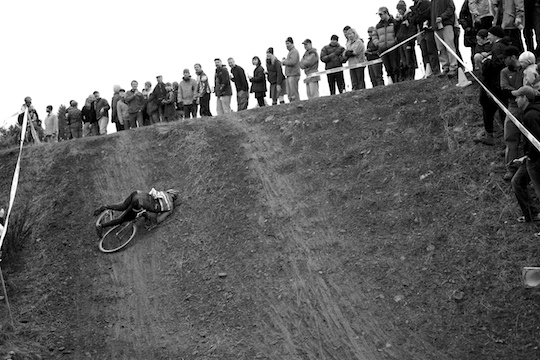 Another type of long form story is the essay on a subject. I've been photographing cyclocross for nearly four years, building a body of work that doesn't have a rigid structure. Instead, I try to get at the essence of each day's races and let that drive the narrative.
Another type of long form story is the essay on a subject. I've been photographing cyclocross for nearly four years, building a body of work that doesn't have a rigid structure. Instead, I try to get at the essence of each day's races and let that drive the narrative.
